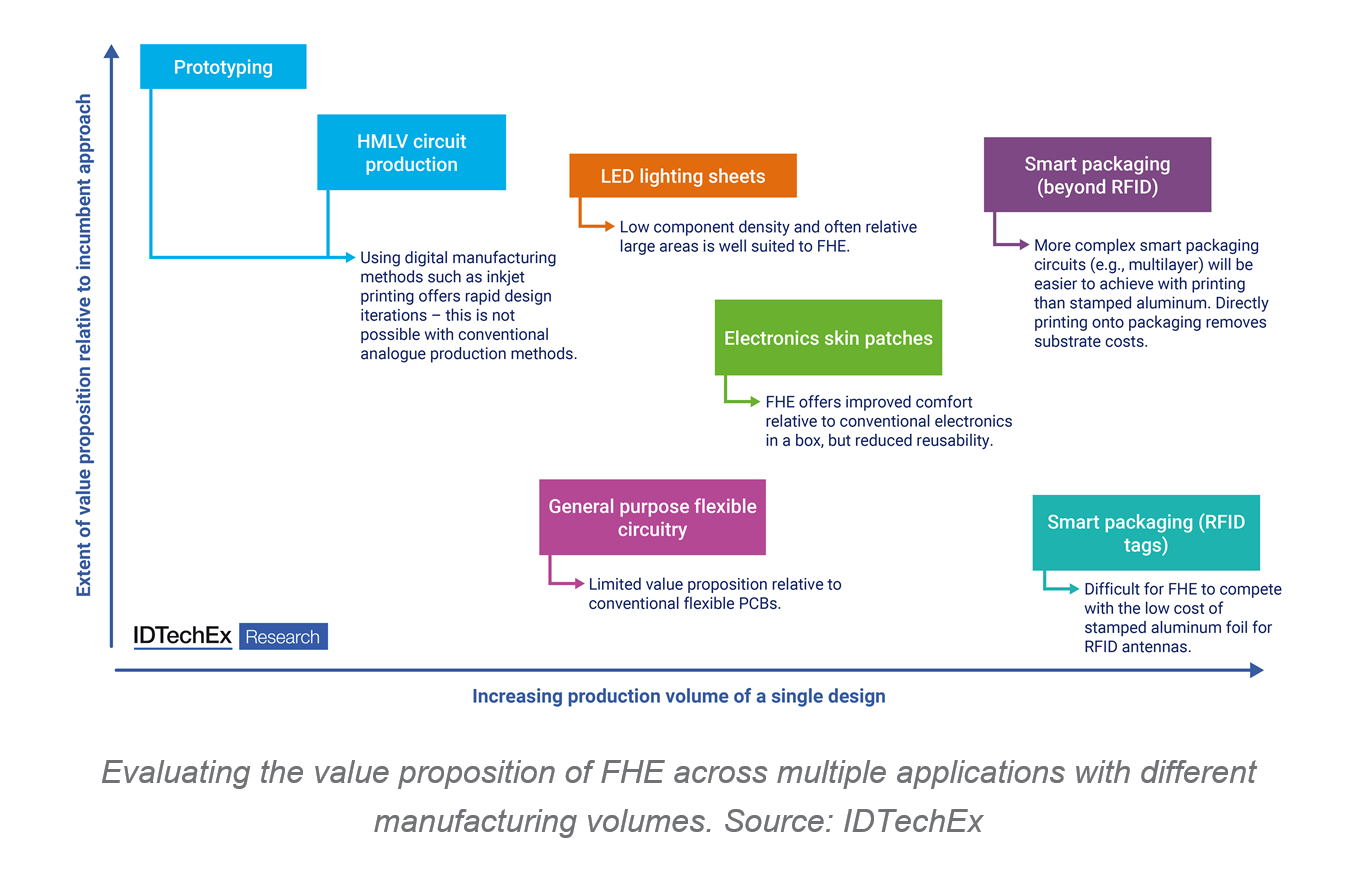Where do flexible hybrid electronics add the most value?
Can digital and/or high throughput manufacturing be applied to circuit boards? Can stretchable electronics be produced without sacrificing processing capabilities? Flexible hybrid electronics (FHE) is an emerging manufacturing methodology that aims to resolve both of these questions.
By combining aspects of printed and conventional electronics, specifically conductive inks patterned on a flexible substrate with mounted components such as integrated circuits (ICs), it represents a compelling ‘best of both worlds’ solution.
Matching value propositions to applications
At its core, FHE is an alternative approach to circuit manufacturing. As such, FHE circuits can, in principle, be used wherever comparatively simple PCBs are needed (i.e., not complex multilayer circuits). Of course, replacing an established incumbent technology requires a compelling advantage that is typically application-dependent – do not expect FHE circuits to displace the PCB in most consumer electronics anytime soon.
Relative to existing flexible PCBs, FHE offers 3 distinct value propositions: Additive digital manufacturing, conformality/stretchability, and compatibility with roll-to-roll (R2R) manufacturing. The key to successful commercialisation is finding a product-market fit where one or more of these value propositions either justifies switching or to facilitate a new application that would not otherwise be possible.
Additive digital manufacturing
Since conductive ink can be printed using digital methods such as inkjet or the emerging laser-induced forward transfer (LIFT), FHE enables additive digital manufacturing. FHE is thus well suited to prototyping and very high-mix low-volume (HMLV) manufacturing – it could also potentially be deployed to facilitate versioning and even ‘mass customisation’, the latter of which is difficult to envisage without digital manufacturing.
Additive manufacturing is less wasteful than more established subtractive approaches and is thus especially advantageous when components and, hence, conductive traces are widely spaced. One such example is mounting LEDs on sheets for large area lighting, which can also be produced by R2R manufacturing.
Conformality/stretchability
Conformality/stretchability is a key value proposition of FHE. Whereas flexible PCBs often employ rigid islands for mounting packaged ICs and other rigid SMD components, FHE circuits can be more flexible since many components (e.g., sensors) can be printed. Furthermore, conductive inks that are either stretchable or can withstand bending enables a shorter bending radius and even stretchability.
The flexible (and potentially stretchable) form factor makes FHE ideally suited to wearable technology, including electronic skin patches and e-textiles since it improves wearer comfort relative to the current rigid boxes that contain conventional electronics. Challenges include washability and sustainability concerns relative to reusable rigid electronics mounted within a removable box.
R2R manufacturing
For large-volume manufacturing, conductive traces can be printed using rotary analogue methods such as flexography, gravure, and rotary screen printing. This enables very rapid deposition via R2R manufacturing, reducing costs. Cost benefits are especially significant if traces can be printed onto existing surfaces (such as packaging labels), eliminating the need for a dedicated structure.
Given the large volumes required and relatively low value-add per item, minimising costs is essential for electronics to be adopted for smart packaging/RFID. While most RFID tags currently use stamped aluminium foil for antennas, printing with copper inks will reduce costs and improve sustainability. R2R FHE production is forecast to expand to more sophisticated smart packaging circuits with greater functionality, such as sensing.
Comprehensive insight
IDTechEx’s report ‘Flexible Hybrid Electronics 2024–2034’ evaluates the status and prospects of FHE circuits, which we forecast to reach a market size of around $1.8 billion by 2034 – more if the associated infrastructure, software, and services are included.
Drawing on years of following the printed electronics industry and 40 interview-based company profiles, the report outlines trends and innovations in the materials, components, and manufacturing methods required. It explores the application sectors where FHE is most likely to be adopted, drawing on current activity and in-depth discussions with contract manufacturers and potential adopters. Granular market forecasts break down the opportunities for FHE circuits across five application sectors (automotive, consumer goods, energy, healthcare/wellness, and infrastructure/buildings/industrial) into 39 specific opportunities, such as skin temperature sensors and printed RFID tags.











